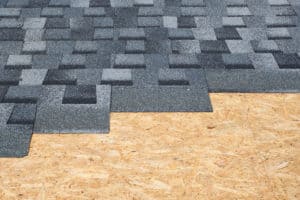How to Calculate Roofing Square Footage
If you find yourself in need of a new roof and want to know how much it will cost you (without calling a roofer…yet) there are a few calculations you can make to figure out how much roofing material you need, including shingles (i.e., shingles per square foot), ridge caps, and more.
To do this, you need to calculate the total area of your roof. But first you need to determine your roof pitch. Here’s how to do it correctly:
Contents
Step 1. Measure the roof pitch
To accurately calculate the area of your roof, you must first start by measuring the slope of your roof (or your roof pitch). For this you need the following materials:
- ladder
- Measuring tape
- Great level
Then follow these steps:
Step 1. First you need a tape measure and a large level. Use your tape measure to measure 12 inches on the level and mark the 12-inch line.
Step 2. Next you need a ladder. Place the ladder against the gable end of the roof. Be sure to take proper safety precautions when doing this, especially if you have a steep roof.
Step 3. Climb to the top of your roof and level yourself against the gable roof and flat against the side of your house.
Pro Tip: Wondering what a gable roof or gable roof is exactly? This is used to finish the edge of the top portion of a sidewall that reaches a triangular point at the ridge of a sloping roof plane.
Step 5. Now it’s time to calculate the rise of your roof. To do this, use the tape measure to measure from the 12-inch mark on your level to the bottom of your siding.
Step 2. Estimate your roof area
Once you have your roof pitch, this will help eliminate a lot of extra measurements because you can use the roof pitch to get an approximate number of square feet of your roof:
Step 1. Use the number you landed on for the slope of your roof, then divide the number by 12.
For example, if the slope of your roof is 6 by 12, divide 6 by 12. The resulting number is 1/2.
Step 2. Then square your result.
For example, if your number is 1/2, then squared is 1/4
Step 3. Add 1 to your number. (1/4 + 1 = 10/4.)
Step 4. Now it’s time to find out the square root of your new number.
In our example, the square root of 10/4 is 1.58
Step 5. Next, you want to calculate the square footage for a of your home. To do this, divide the total square footage of your home by 2.
For example, if you have a 3,000 square foot house, this number would be 1,500.
Step 6. Multiply the square footage of one floor by your square root and voila! You now have the estimated square footage of your roof. (1,500 x 1.58 = 2,370 square feet.)
Step 3. Calculate the exact roof area
To calculate accurate roof dimensions that the exactly area and the total square footage of your roof, there is also a way to do this – it just requires a little more legwork and you need to know the length and width of your house.
You will need your tape measure and ladder again for this.
Step 1: Divide your roof pitch by 12, just like we did above.
Step 2: Square your result.
Step 3: Then add 1 to your number.
Step 4: Calculate the square root of the above number.
Step 5. Use your tape measure to determine the length and width (horizontal run) of your home, including any overhangs.
Step 6. Multiply your house length by your house width. The resulting number is your area.
Step 7. Then multiply the area by the slope of your roof.
Pro Tip: You want to consider the ‘waste factor’. Roofers usually add anywhere from 10 to 15% to the roof’s total square footage to account for the waste factor, but keep in mind that this calculation may vary based on roof style or other roofing materials.

The most common roof types are:
- Gable roof
- Dutch gable roof
- Gambrel roof
- Hip roof
- Mansard roof
- Barn roof
- Flat roof
Be sure to determine which one is yours so you can accurately calculate the wastage factor.

About Christian roofing
Christian Roofing, Inc. is here to provide you with a host of excellent roofing services, whether you want to outfit a seaside cottage or a large corporate warehouse. Our experienced team of roofers are able to work on any residential, commercial or industrial project, regardless of size or scope.

Comments are closed.